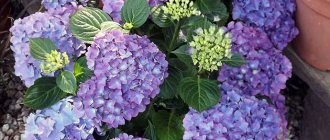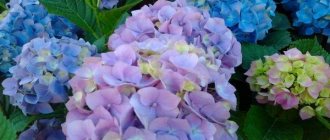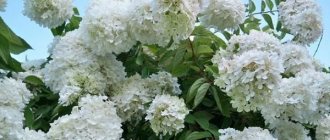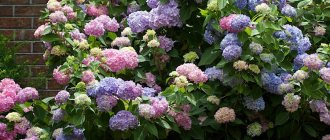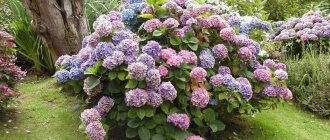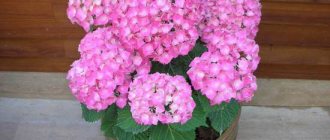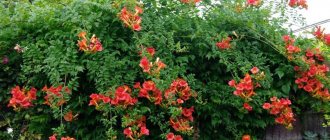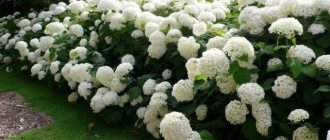Petiole hydrangea (Hydrangea petiolaris), is a species of the genus Hydrangea, a creeping deciduous shrub in the hydrangea family. The species is native to the forests of Japan, the Korean Peninsula and Taiwan. The flowering period is from June to July.
Hydrangea is sometimes called a subspecies closely related to Hydrangea anomala from China and the Himalayas, called Hydrangea anomala subsp. petiolaris. From the petiole hydrangea, the rejected hydrangea differs in size (the rejected petiole grows up to 12 m) and the diameter of the inflorescence is up to 15 cm.
Description
Petiolate hydrangea is a climbing plant with a height of 9–15 (up to 20) meters. Attached to the support by aerial roots. The leaves are glossy, broadly ovate, pointed, serrated with a long petiole, deciduous. The inflorescences are flat, approximately 20 cm. White sterile flowers have a circumference of 2.5–4.5 cm; in the center of the inflorescence there are smaller whitish fertile flowers with a diameter of 1–2 mm. The fruits are capsules, the seeds are small.
The dark green, glossy leaves of Hydrangea petiolate bloom in the spring, earlier than other deciduous climbing plants (for example, Maiden grape). The leaves are heart-shaped, smooth, long with serrated edges. Leaf density varies from plant to plant depending on the immediate growing conditions. Side branches tend to grow at right angles to the main vines.
The shoots form an uneven foliage pattern that is not possible with common climbing plants such as Maiden's Grape or Common Ivy. Petiolate hydrangea begins to bloom in June earlier than other frost-resistant hydrangeas. The inflorescences, usually 15 cm or more in diameter, consist of several hundred small fertile flowers surrounded by a crown of a dozen or more sterile ones. The sterile flowers are white, on long stalks, emphasizing their peripheral position.
The calyxes of sterile flowers are greatly enlarged, up to 2.5 cm in length and almost the same width, and have rounded outlines. The white color persists long after the fruiting flowers have faded, giving the impression of an unusually long flowering period.
The fruit is unattractive and technically a capsule (2.5 cm long). In winter, the stems and side branches have an interesting pattern, the yellowish-orange bark unevenly peeling off into large thin flakes.
Origin and appearance of hydrangea
Under natural conditions, petiolate hydrangea is found in sparse coniferous and deciduous forests of Japan, Korea and Sakhalin, located near the sea. It has been grown as a cultivated garden plant since 1865.
Hydrangea petiolate
The leaf blades of this shrub are large, dark green, with a pointed base. With the onset of autumn they become yellow, and closer to November they completely fall off. Climbing hydrangea takes any shape and envelops objects. However, it does not have a branched trunk. Landscape designers effectively use this feature and also combine the flower with other plants on the site. The dense foliage of hydrangea can create shade for the windows of a house, protecting them from the summer heat.
The flowers are white, pale pink or pale purple. They are collected in thyroid inflorescences with a diameter of about 20 cm. Thanks to its strong aroma, the plant attracts bees and is considered a honey plant. The flowering period lasts more than 2 months, beginning in mid-June.
Petiole hydrangea has long been grown in gardens
Story
Hydrangea petiolaris, a species known as the "climbing hydrangea," was introduced into horticulture in the United States in 1865 by Thomas Hogg, who was consul to Japan and, with his brother James, ran a nursery in New York. In addition to their own nursery, the brothers distributed seeds at Parson's Nursery in Flushing, New York. The Arboretum received seeds from Japan (presumably subspecies petiolaris) and has been growing it as a species since then. According to Haworth-Booth, Hydrangea anomala subsp. anomala was introduced to Britain in 1839 with subsp. peliolaris around 1878.
Similar, but not her! Be careful when purchasing: Schizophragma hydrangea
Plants from another close genus Schizophragma are also called hydrangeas. Sometimes, under the guise of petiole hydrangea, you can find Schizophragma hydrangeoides on sale from unscrupulous or simply illiterate sellers. This plant is also from the Hydrangeaceae family, but, unfortunately, it is not winter-hardy at all.
in the photo Schizophragma hydrangea, similar to petiolate hydrangea, but not winter-hardy
Landing
Petiolate hydrangea takes root slowly, may not produce growth for a year or even two and blooms poorly after transplantation, prefers rich, well-drained, moist soil, and will grow in sun or shade. Once established, it has no serious pest problems. In the first two to three years after planting it grows rather slowly, but after rooting it accelerates the growth rate. Tolerates air pollution well and can grow in cities and industrial areas.
The first year or two after planting, growth may be slow or seemingly non-existent. As the bush takes root, especially if the tips of the stems can be securely attached to supports or structures, growth becomes surprisingly fast: 50-150 cm per year.
Before planting climbing hydrangea, the soil should be weeded and dug deep. It is better to plant the vine a little further from the supports, then direct the shoots towards them. The supports themselves must be strong to support the weight of an adult shrub. The distance between plants is 1.5-4 meters. In places exposed to strong gusts of wind, hydrangea shoots may break off their supports and fall to the ground; in such conditions, it is a good idea to tie up the plants.
Varieties and varieties of climbing hydrangea with photos
The climbing plant has many varieties. The most popular are these.
Petiolaris
It is considered the largest vine of all climbing hydrangeas. It is petiolaris that can reach 25 meters in length and entwine an entire house.
Cordifolia
Blooming cordifolia, painted in delicate creamy tones, leaves no one indifferent.
This dwarf (compared to its companions) one and a half meter vine is notable for its unusual leaf color: the upper part of the leaf plate is green, and the lower part has a light, almost white tint.
Miranda
This variety is interesting for its unusual pointed shape of leaf plates covered with light veins.
Take a chance
It is considered one of the most attractive vines. Thanks to the light edging on the leaves, this hydrangea does not lose its high decorative qualities even outside the flowering period.
Winter surprise
The foliage of this medium-sized hydrangea is remarkable: it tends to change color from dark green to cherry when exposed to frost.
Silver lining
The pleasant aroma of this hydrangea flowers attracts bees. The plant can grow a little more than 5 meters, and is often used in garden design as a ground cover plant.
Where to plant?
Liana is great for cladding walls with porous surfaces, landscaping walls and fences, covering trash cans, covering gazebos, covering pergolas, trellises and posts. It looks very picturesque on the trunks of old trees. Climbing hydrangea is a good alternative to ivy; unlike ivy, it almost never freezes.
Hydrangea should not be planted too close to tree trunks or building walls; in these places the plant may experience a lack of water.
Decorative qualities
All varieties of hydrangea are very beautiful and are widely used in the design of various landscape areas. This plant can be planted to decorate various garden buildings. Thanks to its ability to quickly adapt to new conditions, it will grow abundantly within a couple of years after planting. To ensure proper growth, you can create support from wire. Thus, the vine will tightly cover the entire vertically created surface.
Petiole hydrangea flowers are white, but if desired they can be painted blue. To do this, you need to buy a special bluing substance, which is sold at any gardening store. You can also take aluminum sulfate and sprinkle it on the ground around the plant. The plant cannot be harmed by these means, and after a while its flowers will turn blue. A liana of this color will have an interesting appearance in a decorative composition on a fence.
When placing petiole hydrangea in a garden plot, you need to know certain rules. Although the plant is not very demanding, it must be placed correctly so that the flower takes root.
Subtleties of placing petiole hydrangea:
- frost resistance: the plant is winter-hardy, it can withstand the middle zone climate without damage;
- lighting: hydrangea loves light very much, it needs to be placed in an open place, since it will bloom only in good light (it grows very slowly in the shade and has small flowers);
- the soil should be moist, drained, and in no case should you overdo it with watering.
This plant is not very demanding on the acidity of the soil, but it is recommended to add peat to it. You should not use calcareous soil, as the plant does not like it very much and will not grow well.
Since climbing hydrangea covers the ground as it grows, as if it were a huge carpet, it can be used to cover a certain area of the site. For example, place it in a rock garden, plant it on an alpine hill, it harmonizes perfectly with the stones. Thus, this climbing plant species can entwine even a very large stone, creating unusual compositions of large flowers and leaves. On a flat surface, hydrangea grows very quickly, and with its help you can decorate a large flower bed. The plant can also be placed in a vertical position to decorate a wall or stone fence.
Petiole hydrangea does not want to grow and develop on mesh-shaped fences, so it does not live long in such conditions. If you make a support in the form of a column or a flat wall, the plant will quickly grow and be very lush. If you regularly carry out correct and timely pruning, a thick green carpet will be formed covering the entire perimeter of the wall. This solution would be ideal for a summer residence.
Care
Climbing hydrangeas are relatively easy to grow. It is especially important to choose the right place so that the vine does not cause serious problems in the future. The shrub grows best in partial shade or shade, in a place protected from the wind. Young specimens are especially susceptible to drought and require regular watering. The species is completely hardy in USDA zone 4, but may not bloom in USDA zone 8.
When the vine reaches the upper limits of available support, climbing hydrangea reacts in the same way as ivy: it switches from vegetative growth to sexual maturity and produces flowers. Thus, a climbing hydrangea climbing a 10-meter-tall tree trunk may not bloom as quickly as one that only has a meter-long pole to climb. If flowering is a priority, provide relatively short support structures such as a 3-5 meter pole or wide ones such as stone walls.
Proper fertilizer is important when planting petiolate hydrangea next to a tree; due to tree competition, the soil can quickly run out of nutrients. Hydrangeas can be fertilized with well-decomposed compost or manure. Also mineral fertilizers for hydrangeas. All-purpose fertilizers are not suitable due to their calcium content. Excess calcium in the soil quickly leads to chlorosis (slight discoloration) of the leaves. Hydrangeas are fertilized from spring to mid-July. Then the plant is allowed to rest before winter.
The moving stems are amazingly inflexible and can break when trying to straighten them. To make matters worse, the older and thicker the stems become, the more brittle they become.
Climbing hydrangeas usually do not require pruning . If you need to limit its growth or give it shape, you can prune it when the vine finishes flowering.
Propagation of climbing hydrangea . Like other types of hydrangea, it can be propagated by summer cuttings. However, in amateur conditions it is easier to use layering.
Pests and diseases
Common diseases of petiole hydrangea include the following:
- Chlorosis — there are several sources of this disease (viruses, fungi, vector pests), and it can also occur due to a lack of minerals in the soil (iron, magnesium). The leaves turn yellow and fall prematurely, shoot growth activity decreases, and the tops dry out. In case of non-infectious damage, special fertilizers will help; in case of infectious damage, the infected plants are destroyed.
- Gray rot - this disease affects the entire plant, gray-brown dry spots appear on it, over time they become wet and covered with plaque. Measures to combat the disease include spraying with solutions of “Fitosporin-M”, “Alirin-B”, “Euparen multi”, “Fundazal”. Affected parts must be cut off and burned.
- White rot - a fungal disease caused by the sclerotonia fungus. It first attacks the roots, then the entire plant. The above-ground part is covered with a white coating, and the underground part is covered with a mucous mass; in damp weather, the bush rots and dies. To combat the disease, “Topsin”, “Previkur”, “Ridomil Gold”, “Profit Gold” are used.
- Root-knot nematodes - small worms about 2 mm long, infect the roots, swellings appear on them, which eventually rot and die. You can fight these pests with the help of the drugs “Nematofagin BT”, “Nematorin”, “Bassamil”.
Reproduction by layering
Since old stems are notoriously fragile, in early spring you need to select a young, thin stem that is low, long and flexible enough so that the shoot can be easily bent to the ground. Place the brick on the soil-covered stem to support it (if necessary) and to prevent rain from washing away the soil. Drive a thick stake into the ground next to the buried vine, covered with soil, and tie the top of the stem to it as close as possible without breaking the stems; if there is support, the vine will take root faster.
Agricultural technology of culture
Hydrangea petiolate climbing
Proper cultivation of petiole hydrangea requires that the gardener takes into account temperature indicators and carries out all the required agrotechnical measures. The place for planting the plant should be chosen in the shade - a wall of a house, a high fence, the presence of nearby trees or tall shrubs. Direct sunlight is harmful to hydrangea and can cause disease and weakening.
Petiolate or climbing hydrangea grows well in loose soils that have a lot of humus. The ideal acidity indicator is 4.5-5 pH. It is prohibited to use ash as fertilizer. Peat and compost are used to accelerate growth and development. The watering regime should be regular and frequent. Planting is carried out when the likelihood of frost passes - in early May. The air should be warmed up at night to +5-10 degrees, the ground - +8-10 degrees.
Attention! An average of 35 liters of water should be poured under a hydrangea bush.
Culture propagation
Every garden owner, when thinking about planting hydrangea, should know the features of its propagation. There are several ways:
- division;
- cuttings;
- layering.
We must remember! Division is used when the hydrangea bush develops well and produces abundant young growth. In this case, you can get a new plant by separating young shoots from the mother (the new stem should not be damaged).
Feature - the shoots need to be shortened (leaving a few buds), the root carefully trimmed and treated in a solution of potassium permanganate for additional disinfection. Planting is done in prepared holes in the spring. During the first month, the seedling requires abundant watering.
Also, decorative climbing hydrangea can be propagated by cuttings. In this case, shoots of 10-15 cm are used. The peculiarity is that you need to make a choice in favor of the woody ones. If this method of reproduction is assumed, then it is optimal to carry out work in early summer. To do this, select a shoot that has 2 nodes. You need to carefully cut off the top and remove 2-3 leaves located at the bottom. To speed up the process of survival and growth, it is recommended to treat the future seedling with a stimulant. Then the prepared shoot must be planted in a box with a mixture of peat and sand. Care must be taken to ensure that the soil always remains moist. The box is then covered with film to create optimal conditions for further development. It is recommended to remove it when the plant is completely strong.
Reproduction
An additional method of propagation is layering. The peculiarity of this method is that the gardener will need to be extremely careful, since the lower branch of the plant will need to be bent to the ground and fixed. The soil under the hydrangea should be loose and well-moistened. You will need to make a cut where the branch touches the ground. The next stage of propagation using this method will be mulching with peat. There are two periods when the layering method is optimal: late spring (early May) and late summer (early August).
Growing from seeds
Petiolate hydrangea can also be grown from seeds. In this case, it is recommended to first create all the necessary conditions so that the plant does not freeze during the process of germination and development. It is not recommended to choose open ground for this purpose, since in many regions frosts are possible even in the spring: Siberia, the Urals.
Important! Hydrangea is a branched vine that will require support for further development, so a place for planting must be selected in advance.
Hydrangea seeds are small and require a special growing method. It is recommended to plant them in wooden or plastic boxes filled with fertile soil. It needs to be watered well before placing the seeds. It is recommended to cover the container with glass (light) after this.
The boxes should then be placed in a warm place. As the plant grows, it needs the room to be warm. The optimal temperature is 15-23 degrees. Next, you need to take care of it, just like the rest of the seedlings: water it on time, observe the temperature regime and air humidity levels. Climbing hydrangea grows, like any other variety, after 1.5 months (the first shoots appear). Feature - seedlings may appear unevenly in containers. Subsequent growth is also slow. A prerequisite for caring for seedlings is picking. It is produced when the cotyledon leaves appear - April. Also carried out in May, when there is enough heat and light outside.
Important to remember! Planting in open ground is not carried out immediately. 2 years after germination, the plant should develop in the containers in which the seeds were planted. In summer, boxes (or pots) need to be dug in, choosing an area with light shade. With the onset of autumn, the plant needs to be brought indoors. Hydrangea is planted in a permanent place in the third year (after two winterings).
Cultivation care
An important element is courtship. Petiolate or climbing hydrangea, planted and caring for which requires certain knowledge, is a decoration not only for the site, but also for the house (its external walls). For lush flowering of the bush when caring, you need to adhere to certain rules. There are watering tips that need to be followed to avoid plant problems and diseases. It loves moisture very much, but waterlogging can negatively affect the root system.
Timely watering
In summer, timely watering is necessary to ensure abundant growth and good flowering of hydrangeas.
We must remember! For each bush you need to use at least 30 liters of water during watering. In dry weather, it is recommended to carry out this element of care 2 times a week. The rest of the time - once a week. After mulching, watering is carried out in the same way, once every 7 days.
The flower needs timely feeding. This stage of care is required for the plant to grow lushly. The procedure is carried out several times per season. The first feeding should be done in spring. To do this, prepare a solution of urea (20 g), superphosphate (30 g), and potassium sulfur (30 g). The second feeding is carried out during the period when buds begin to form. For irrigation, you need to prepare a solution containing: superphosphate (60 g), potassium sulfate (40 g). The third feeding is done in August. In this case, 15-20 kg of compost must be placed under each bush. To give strength, the liana-shaped plant needs to be watered with a weak solution of potassium permanganate. It also allows for pest control and disease protection.
We must remember! Petiolate or climbing hydrangea, like any other plant varieties, needs pruning.
This stage avoids compaction and helps maintain the neat appearance of the vine. Basic rules for pruning:
- carry out only on bushes older than 3 years;
- carry out in early autumn (after the snow has completely melted);
- leave 10 strong shoots;
- Leave 3-5 pairs of buds on annual shoots.
It is necessary at this stage to remove dry inflorescences and repeat the process during preparation for winter. This is necessary so that the plant blooms earlier next season.
Hydrangea has good winter hardiness, but for young seedlings (1-3 years old) it is recommended to provide additional light shelter and also tie them up to create support. Good neighborhood - weigela, jasmine.
Hydrangea Petiolaris
Use in the garden
Petiolate hydrangea can be effectively used as a ground cover plant in hard-to-reach places. Good for stone fences or brick walls, although the growth rate is slower in such areas, the growth rate increases if the vine is wrapped around a tree.
When growing petiole hydrangea, you should take some precautions. In the case of a wall, especially in a building, the vine should be grown on the dark side.
The north or northeast side is better suited for growing. If grown in the south, the bush may be damaged by the sun and perform poorly.
It should be noted that hydrangeas drop all of their leaves as one unit, usually in early winter, which can be a challenge when harvesting. Therefore, planting against a wall behind existing plantings such as Rhododendron and Enkianthus should be avoided. Petiolate hydrangea climbs by means of secondary roots, which, penetrating into the substrate, apparently cause little damage than other climbing plants. Haworth-Booth suggested growing petiolate hydrangea along with beautiful Nasturtium.
A fine example of Hydrangea petiolate grown from seed in 1892 can be seen in the northeast corner of the office building on Jamaica Plain.
Growing a climbing hydrangea on a tree should be started on a mature specimen, since over time the vine will begin to grow quickly and braid all the branches.
Petiole hydrangea in landscape design
The petiolate shrub is widely used in landscape design; it is used to form green hedges, flowering barriers, and decorate gazebos, arches and pergolas (canopies), and walls. It can grow without supports, as a ground cover, creeping plant. Planted either singly or in groups with other flowering crops or perennial herbaceous plants.
Did you know? In Buddhism, tea made from hydrangea leaves is considered a ritual drink; during the Hana Matsuri holiday, it is poured over the statue of the newborn Buddha.
Hydrangea is petiolate, climbing, ground cover or climbing vine - very unpretentious in care. You just need to adhere to the rules of cultivation, carry out preventive work in a timely manner, then it will give your garden a special charm, become a good decoration and will delight you with its blooming and lush appearance.


